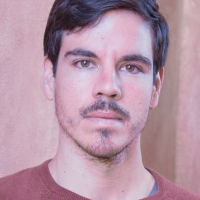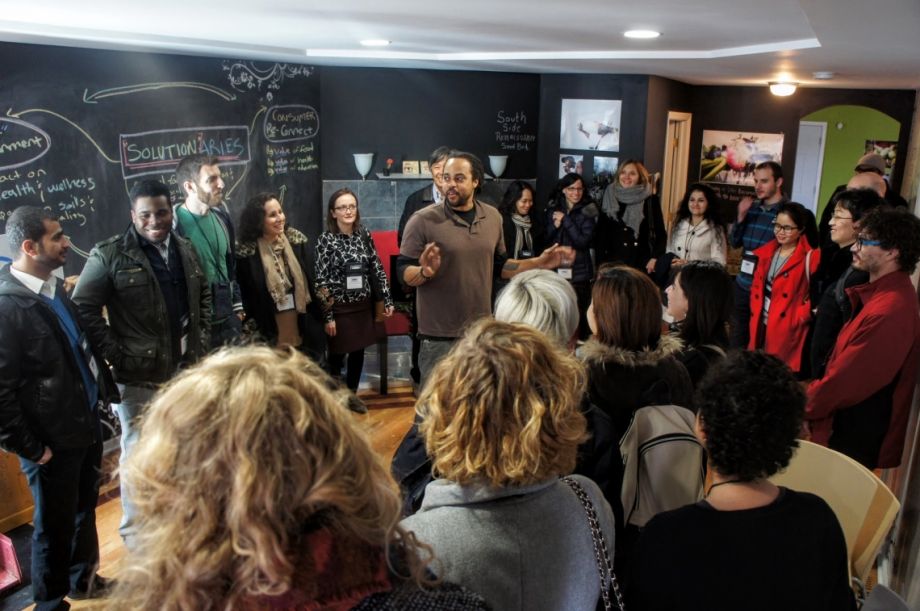As Javier Torres walked along the blocks of once-blighted properties in the nexus of Perry Avenue, and 57th and 59th streets in South Side Chicago, he was struck by the writing on the sidewalk.
“You see gang signs that are literally sprayed on the ground so you know whose territory you’re walking into,” says Torres. But at the Perry Avenue Commons, a local community revitalization effort that’s headquartered in what’s called the Think-Do House, those divides were dissolved by a greater cause.
“Everyone there spoke about how people come from all sides, with all sorts of gang affiliations, and that it’s a safe space,” he says. “It was really great to hear those young men get to express their understanding of how they get to lead in working with land and urban environments, and feel safe in their own community.”
Led by Emmanuel Pratt, the Perry Avenue Commons project was one of 29 awarded a combined total of $11 million through ArtPlace America’s National Creative Placemaking Fund in 2016. After combing through 1,400 applications, Torres, ArtPlace’s director of national grantmaking, traveled the country to visit finalist sites in person to see the potential for each applicant’s human impact.
At the Perry Avenue Commons’ urban agriculture and aquaculture projects, and through apprenticeship programs in carpentry and urban farming that Pratt’s Sweet Water Foundation is coordinating with Chicago Public School’s Career and Technical Education program, it was evident that this project was doing more than just giving people local jobs. It was giving them a new reason to love their neighborhood.
The National Creative Placemaking Fund looks for blueprints that enable residents to “use arts and culture strategies to strengthen the social, physical, and economic fabric of their communities.” These projects aren’t as direct of a response to social ills as traditional methods of community reinvestment, like massive affordable housing projects or workforce development pipelines, but Torres believes placemaking and art can be just as influential in turning a neighborhood around.
“We don’t think it’s a binary conversation,” says Torres. “Jobs can be temporary, even if they’re middle-wage jobs, but how do we also include investment in the social, cultural fabric that will sustain beyond all types of investment?”
On top of a community center and local farms in abandoned lots that provide up to 200 families in South Side Chicago with fresh food every week on Fridays during the summer, the Perry Avenue Commons apprenticeship program is currently training 15 people from Washington Park, Englewood, Roseland, North Lawndale, Chatham — areas that have been crippled by gang violence and disinvestment over the past few decades, according to Pratt.
It’s why he calls the Perry Avenue Commons project a foray into “urban acupuncture.”
“We’ve activated certain types of installations in various select stress points” in the neighborhood, he says. “Now that there’s local ownership, local commerce, the farms, restaurants, juicers, we feed the neighborhood — we recognize that this growth and expansion is just maximizing capital and return of investment off the land.”
ArtPlace has invested $77.7 million into projects in 45 states along with Washington, D.C., Puerto Rico, and the U.S. Virgin Islands since 2011. But how you measure the impact of each individual project, when they vary wildly in size and concept, is a metric Torres and his colleagues are still figuring out.
“It’s a retroactive analysis,” Torres explains. “Real community transformation doesn’t happen two, three, four years at a time. Although creative placemaking isn’t new, there hasn’t been a lot of research in the ways to measure its success.”
Other projects that got cash this year include El Salon + Casa Patio initiative in San Ysidro, California, a city near the U.S.-Mexico border where affordable housing and community investment have been lacking. Teddy Cruz and Fonna Forman, from the University of California, San Diego’s Cross-Border Initiative, and local nonprofit Casa Familiar will use the money to turn a historic church into a community center. The long-term goal there is to start rebuilding an area that faces the greatest shortage of public spaces and affordable housing in the city.
And in Puerto Rico, in the Machuchal neighborhood, community groups Casa Taft 169 and La Maraña are letting local residents work directly on a project to rebuild a 40-year-old abandoned property into Puerto Rico’s first-ever community-run civic center.
They may not be promising hundreds of jobs, or betting on reversing the tide of poverty in their locale, but Torres says it’s the way these projects blend with job programs and affordable housing development to rebuild hope and pride in the community.
“People need jobs, and people need homes, but how do we combine some of the social and cultural elements beyond the fact that people need money to take care of their families?” he says. “These [grantees] are really thinking holistically about the way in which a project can fit holistically in that ecosystem.”
The Equity Factor is made possible with the support of the Surdna Foundation.

Johnny Magdaleno is a journalist, writer and photographer. His writing and photographs have been published by The Guardian, Al Jazeera, NPR, Newsweek, VICE News, the Huffington Post, the Christian Science Monitor and others. He was the 2016-2017 equitable cities fellow at Next City.

















